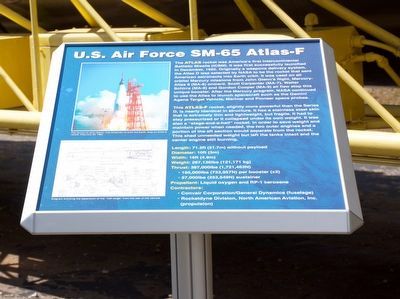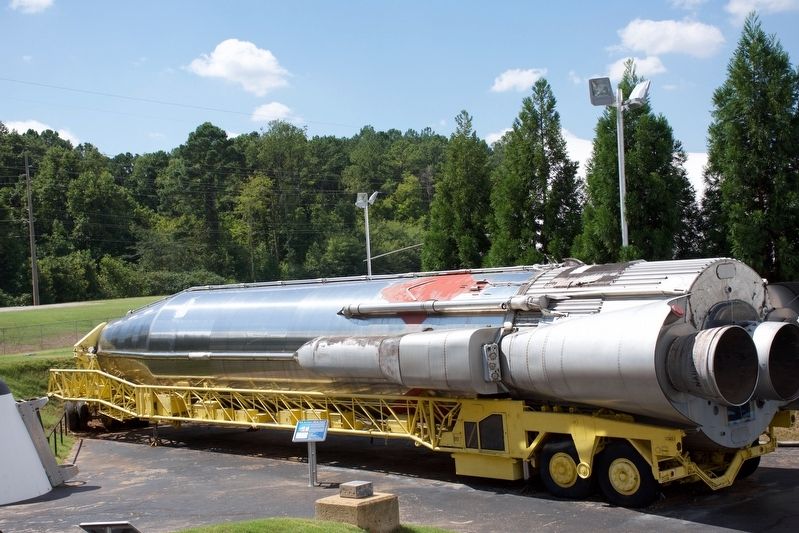Huntsville in Madison County, Alabama — The American South (East South Central)
U.S. Air Force SM-65 Atlas-F
The ATLAS rocket was American's first Intercontinental Ballistic Missile (ICBM). It was first successfully launched in December, 1955. Originally a weapons delivery system, the Atlas D was selected by NASA to be the rocket that sent American astronauts into Earth orbit. It was used on all orbital Mercury missions from John Glenn's flight, Mercury-Atlas 6 (MA-6) onward. Scott Carpenter (MA-7), Walter Schirra (MA-8) and Gordon Cooper (MA-9) all few atop this unique booster. After the Mercury program, NASA continued to use the Atlas to launch spacecraft such as the Gemini Agena Target Vehicle, Mariner and Pioneer space probes.
This ATLAS-F rocket, slightly more powerful than the Series-D, is nearly identical in structure. It has a stainless steel skin that is extremely thin and lightweight, but fragile. It had to stay pressurized or it collapsed under its own weight. It was also a "stage-and-a-half" rocket. In order to save weight and maintain power when needed, the two outer engines and a portion of the aft section would separate from the rocket . This shed unneeded weight but left the tanks intact and the center engine still burning.
Length: 71.2ft (21.7m) without payload
Diameter: 10ft (3m)
Width: 16ft (4.9m)
Weight: 267, 136lbs (121,171 kg)
Thrust: 387,000lbs (1,721,463N)
• 165,000lbs (733,957N) per booster (x2)
• 57,000lbs (253,549N) sustainer
Propellant: Liquid oxygen and RP-1 kerosene
Contractors:
• Convair Corporation/General Dynamics (fuselage)
• Rocketdyne Division, North American Aviation, Inc. (propulsion)
Topics. This historical marker is listed in these topic lists: Air & Space • War, Cold. A significant historical month for this entry is December 1955.
Location. 34° 42.614′ N, 86° 39.27′ W. Marker is in Huntsville, Alabama, in Madison County. Marker can be reached from Tranquility Base, half a mile west of Madison Pike, on the left when traveling west. Touch for map. Marker is at or near this postal address: 1 Tranquility Base, Huntsville AL 35805, United States of America. Touch for directions.
Other nearby markers. At least 8 other markers are within walking distance of this marker. U.S. Army PGM-11 Redstone (a few steps from this marker); NASA / U.S. Geological Survey (a few steps from this marker); U.S. Army/NASA Juno II (within shouting distance of this marker); NASA Skylab (about 300 feet away, measured in a direct line); Pathfinder Orbiter (about 400 feet away); U.S. Army PGM-19 Jupiter (about 500 feet away); Cernan • Evans • Schmitt (about 500 feet away); Young • Mattingly • Duke (about 500 feet away). Touch for a list and map of all markers in Huntsville.
Also see . . . U.S. Space & Rocket Center. (Submitted on September 26, 2016.)
Credits. This page was last revised on August 16, 2020. It was originally submitted on September 26, 2016, by Sandra Hughes Tidwell of Killen, Alabama, USA. This page has been viewed 676 times since then and 59 times this year. Photos: 1, 2. submitted on September 26, 2016, by Sandra Hughes Tidwell of Killen, Alabama, USA. • Bernard Fisher was the editor who published this page.

